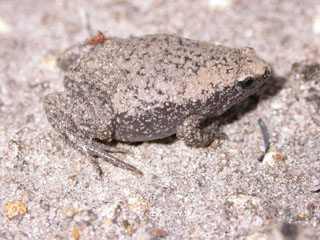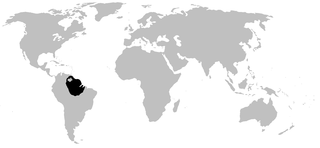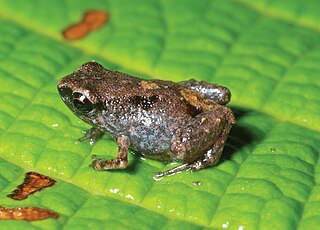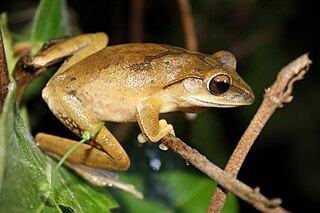
Kitti's hog-nosed bat, also known as the bumblebee bat, is a near-threatened species of bat and the only extant member of the family Craseonycteridae. It occurs in western Thailand and southeast Myanmar, where it occupies limestone caves along rivers.

The Microhylidae, commonly known as narrow-mouthed frogs, are a geographically widespread family of frogs. The 683 species are in 57 genera and 11 subfamilies.

The Tukeit Hill frogs are three species of frog in the genus Allophryne. Originally erected for the species Allophryne ruthveni, the genus was placed as the only member of the subfamily Allophryninae, which was in turn placed in the family Centrolenidae, but they are now considered as the only genus in the monotypic family Allophrynidae.

Asterophryinae is a subfamily of microhylid frogs distributed in an area from the Peninsular Malaysia through the Malay Archipelago to northern Australia.

Limnonectes is a genus of fork-tongued frogs of about 75 known species, but new ones are still being described occasionally. They are collectively known as fanged frogs because they tend to have unusually large teeth, which are small or absent in other frogs.

Polypedates megacephalus, the Hong Kong whipping frog or spot-legged tree frog, is a species in the shrub frog family (Rhacophoridae). In its native range, it is also called "brown tree frog", but this name is otherwise applied to a species of the true tree frog family (Hylidae).
Callulops boettgeri, also known as Boettger's Callulops frog, is a species of frog in the family Microhylidae. It is endemic to Halmahera in the Maluku Islands of Indonesia. It is only known from the holotype collected from Galela in 1894. The genus-level placement of this little known frog has changed many times, and it is still unclear whether it should be placed in some other genus.

Nanohyla perparva is a diminutive species of frog in the family Microhylidae. It is endemic to Borneo and found in Kalimantan (Indonesia), Brunei, and Sabah and Sarawak (Malaysia). The nominal species includes distinct lineages that likely represent different species. Common names least narrow-mouthed frog and Labang forest rice frog have been proposed for this species.

Anilany helenae is a species of frog in the microyhlid subfamily Cophylinae. It is the only species in the monotypic genus Anilany, and is endemic to central Madagascar.

Platymantis insulatus is a species of frog in the family Ceratobatrachidae. It is endemic to the Gigante Islands just northeast of Panay, the Philippines. This frog is variously known as the Gigantes wrinkled ground frog, island forest frog, South Gigante Island frog, Gigantes forest frog, and Gigantes limestone frog. Originally described from South Gigante, it is now known to occur on at least three other islands.
Platymantis spelaeus, also known as the Negros cave frog or cave wrinkled ground frog, is a species of frog in the family Ceratobatrachidae. It is endemic to the Philippines, where it is only found in the forested limestone areas of southern Negros. It is one of the two cave-dwelling Platymantis species, the other one being Platymantis insulatus.

The common green frog is a frog species of in the true frog family Ranidae; some sources still use the old name Rana erythraea. It lives in Southeast Asia and is also known as green paddy frog, red-eared frog or leaf frog. The last name, however, commonly refers to the Neotropical tree frogs which make up the subfamily Phyllomedusinae. These are not closely related to H. erythraea, belonging to family Hylidae instead.
Microhyla mantheyi is a species of microhylid frog. It is endemic to the Malay Peninsula and occurs in southern Myanmar, southern Thailand, Peninsular Malaysia, and Singapore. However, molecular data suggest that the nominal species consists of at least two cryptic species.

Robert Frederick Inger was an American herpetologist. During his lifetime, he wrote numerous books and publications about herpetology. He was also the curator for amphibians and reptiles at the Field Museum in Chicago, Illinois.
Vietnamophryne is a divergent genus of Asterophryinae frogs found in Indochina. Its closest relative is the genus Siamophryne. The genus Vietnamophryne was first described by Poyarkov, et al. (2018).
Vietnamophryne inexpectata is a species of microhylid frog endemic to the Central Highlands of Vietnam. Its type locality is Kon Chu Rang Nature Reserve, Gia Lai Province, central Vietnam.
Vietnamophryne orlovi is a species of microhylid frog endemic to northern Vietnam. Its type locality is Phia Oac-Phia Den National Park, Cao Bang Province, northern Vietnam.
Vietnamophryne occidentalis is a species of microhylid frog endemic to northern Thailand. Its type locality is Doi Tung Mountain, Chiang Rai Province, northern Thailand.

Raorchestes cangyuanensis or Honnametti bush frog is a species of frog in the family Rhacophoridae. It is known from its type locality in the eponymous Cangyuan County in southwest Yunnan, China, as well as from Mizoram in northeastern India and Satchari National Park in Bangladesh; its range presumably includes the intervening Myanmar.














